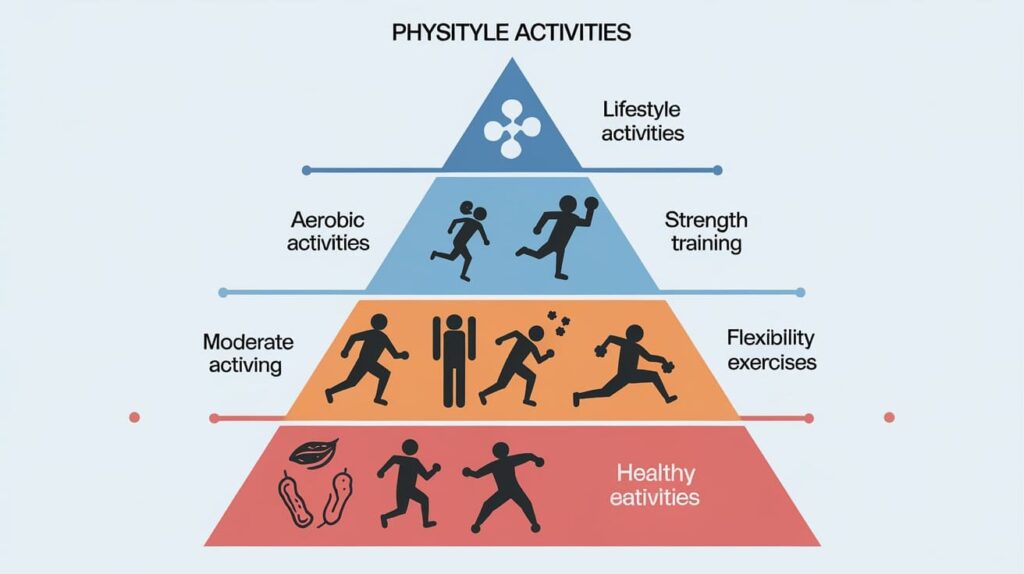Physical activity plays a crucial role in maintaining a healthy lifestyle. But have you ever wondered where different types of activities fit within the Physical Activity Pyramid? Lifestyle activities are an essential part of staying active, but where exactly do they belong in the pyramid? In this guide, we will explore the placement of lifestyle activities on the Physical Activity Pyramid and why they matter for overall well being.
Understanding the Physical Activity Pyramid
What is the Physical Activity Pyramid?
The Physical Activity Pyramid is a visual representation that categorizes different types of physical activities based on their frequency and intensity. It helps individuals plan a balanced exercise routine that includes various forms of movement to maintain good health.
The Four Levels of the Pyramid
The pyramid is typically divided into four levels:
- Lifestyle Activities – Basic everyday movements that contribute to general fitness.
- Aerobic Activities & Sports – Moderate to vigorous exercises that strengthen the heart and lungs.
- Flexibility & Strength Training – Activities that enhance muscle and bone strength while improving flexibility.
- Sedentary Activities – Activities that require minimal movement, which should be limited.
Where Do Lifestyle Activities Belong on the Pyramid?
Defining Lifestyle Activities
Lifestyle activities are everyday physical movements that are often performed as part of a person’s daily routine. These include:
- Walking instead of driving
- Taking the stairs instead of the elevator
- Gardening or yard work
- Household chores like cleaning and sweeping
- Playing with pets or children
Placement on the Pyramid
Lifestyle activities belong at the base of the Physical Activity Pyramid. They form the foundation of an active lifestyle because they require minimal effort to integrate into daily routines while offering significant health benefits.
Benefits of Lifestyle Activities
1. Improved Cardiovascular Health
Even low-intensity activities like walking and housework can improve heart health and circulation over time.
2. Weight Management
By engaging in routine activities, individuals burn calories, which can contribute to weight maintenance and prevent obesity.
3. Enhanced Mobility and Flexibility
Daily movement keeps joints and muscles engaged, reducing the risk of stiffness and improving overall flexibility.
4. Reduced Risk of Chronic Diseases
Regular physical activity, even in small amounts, can lower the risk of heart disease, diabetes, and high blood pressure.
5. Mental Health Benefits
Engaging in movement-based activities helps reduce stress, anxiety, and depression while promoting a positive mood.
How to Incorporate More Lifestyle Activities
At Home
- Stand up and move around during TV commercials.
- Do household chores with extra enthusiasm.
- Engage in active hobbies such as gardening or DIY projects.
At Work
- Take short walking breaks every hour.
- Use a standing desk if possible.
- Walk while taking phone calls.
During Daily Commutes
- Park farther away and walk to your destination.
- Ride a bicycle for short trips instead of driving.
- Get off public transportation a stop earlier and walk the rest of the way.
Comparison: Lifestyle Activities vs. Structured Exercise
| Feature | Lifestyle Activities | Structured Exercise |
|---|---|---|
| Intensity | Low to moderate | Moderate to high |
| Planning Required | Minimal | Requires scheduling |
| Equipment Needed | None | Often required |
| Accessibility | High | Moderate |
| Examples | Walking, gardening | Running, weightlifting |

Common Myths About Lifestyle Activities
Myth 1: They Don’t Count as Exercise
Many people believe that only intense workouts count as exercise. However, lifestyle activities contribute significantly to overall fitness and well being.
Myth 2: They’re Not Effective for Weight Loss
While lifestyle activities alone may not lead to dramatic weight loss, they do help burn calories and support a healthy metabolism.
Myth 3: Only Structured Exercise Improves Health
Research shows that consistent movement throughout the day can be just as beneficial as scheduled workouts.
Conclusion
Lifestyle activities form the foundation of the Physical Activity Pyramid, proving that staying active doesn’t always require structured workouts. Small changes in daily routines can significantly improve physical and mental health. By making conscious choices to move more, individuals can lead healthier, more active lives without the need for strenuous exercise routines.
FAQs
Lifestyle activities should be done daily as part of regular movement and physical well-being.
While they contribute to overall health, incorporating aerobic and strength training exercises is recommended for balanced fitness.
Using a step counter or fitness tracker can help monitor daily movement and ensure adequate physical activity.
Yes! They are accessible for individuals of all fitness levels and age groups.
Setting small goals, finding enjoyable activities, and making movement a social experience can help maintain motivation.




